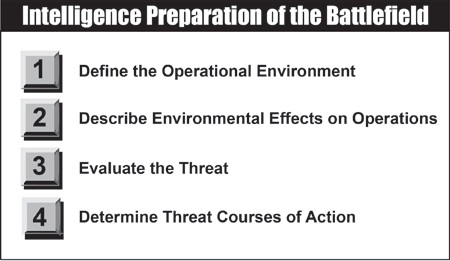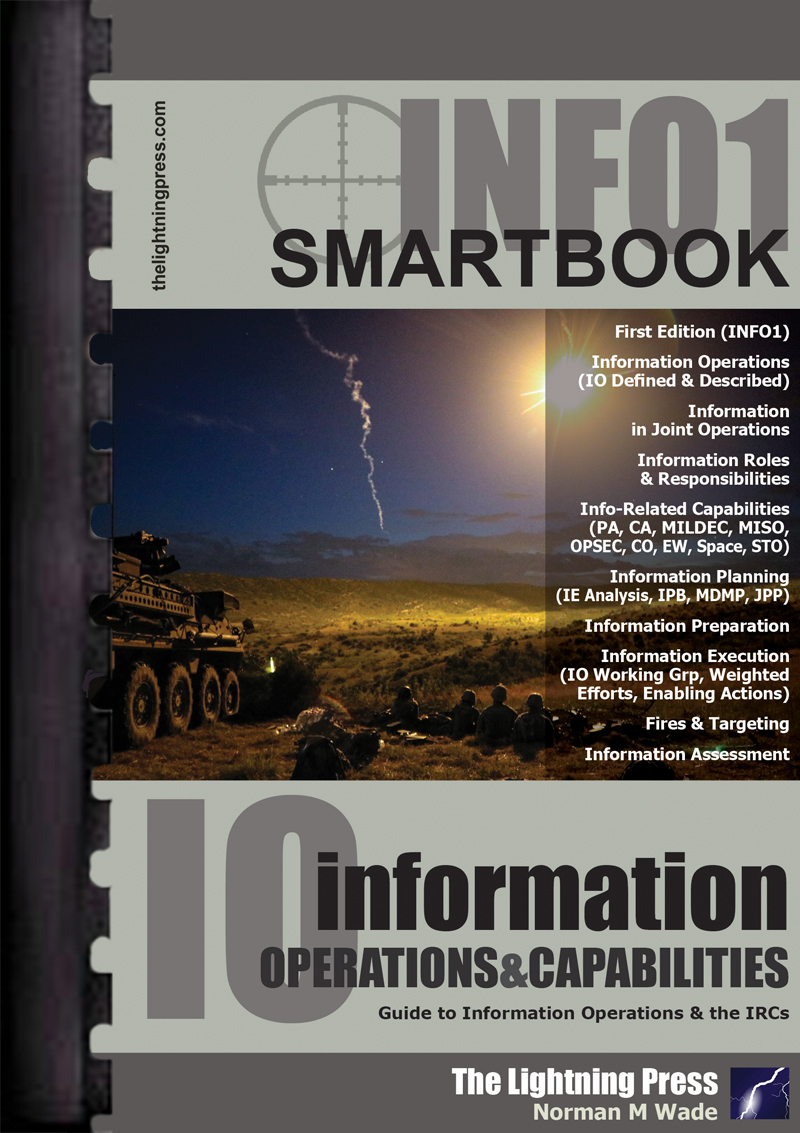Intelligence preparation of the battlefield (IPB) is the systematic process of analyzing the mission variables of enemy, terrain, weather, and civil considerations in an area of interest to determine their effect on operations.
IPB allows commanders and staffs to take a holistic approach to analyzing the operational environment (OE). A holistic approach—
• Describes the totality of relevant aspects of the OE that may impact friendly, threat, and neutral forces.
• Accounts for all relevant domains that may impact friendly and threat operations.
• Identifies windows of opportunity to leverage friendly capabilities against threat forces.
• Allows commanders to leverage positions of relative advantage at a time and place most advantageous for mission success with the most accurate information available.
IPB results in intelligence products that are used during the military decisionmaking process (MDMP) to assist in developing friendly courses of action (COAs) and decision points for the commander. Additionally, the conclusions reached and the products (which are included in the intelligence estimate)developed during IPB are critical to planning information collection and targeting operations. IPB products include—
• Threat situation templates with associated COA statements and high-value target (HVT) lists.
• Event templates and associated event matrices.
• Modified combined obstacle overlays (MCOOs), terrain effects matrices, and terrain assessments.
• Weather effects work aids—weather forecast charts, weather effects matrices, light and illumination tables, and weather estimates.
• Civil considerations overlays and assessments.

The IPB process consists of the following four steps:
Step 1—Define The Operational Environment
An operational environment is a composite of the conditions, circumstances, and influences that affect the employment of capabilities and bear on the decisions of the commander (JP 3-0). An OE for any specific operation comprises more than the interacting variables that exist within a specific physical area. It also involves interconnected influences from the global or regional perspective (such as politics, economics) that affect OE conditions and operations. Thus, each commander’s OE is part of a higher commander’s OE. Defining the OE results in the identification of—
• Significant characteristics of the OE that can affect friendly and threat operations.
• Gaps in current intelligence holdings.
Step 1 is important because it assists the commander in defining relative aspects of the OE in time and space. This is equally important when considering characteristics of multi-domain OEs. Aspects of these OEs may act simultaneously across the battlefield but may only factor in friendly or threat operations at specific times and locations.
During step 1, the intelligence staff must identify those significant characteristics related to the mission variables of enemy, terrain and weather, and civil considerations that are relevant to the mission. The intelligence staff evaluates significant characteristics to identify gaps and initiate information collection. The intelligence staff then justifies the analysis to the commander. Failure to identify or misidentifying the effect these variables may have on operations at a given time and place can hinder decision making and result in the development of an ineffective information collection strategy. During step 1, the area of operations (AO), AOI, and area of influence must also be identified and established.
Understanding friendly and threat forces is not enough; other factors, such as culture, languages, tribal affiliations, and operational and mission variables, can be equally important. Identifying the significant characteristics of the OE is essential in identifying the additional information needed to complete IPB. Once approved by the commander, this information becomes the commander’s initial intelligence requirements—which focus the commander’s initial information collection efforts and the remaining steps of the IPB process.
Additionally, where a unit will be assigned and how its operations will synchronize with other associated operations must be considered. For example, the G-2/S-2 should be forming questions regarding where the unit will deploy within the entire theater of operations and the specific logistics requirements needed to handle the operation’s contingency plans.
Step 2—Describe Environmental Effects On Operations
During step 2 of the IPB process, the intelligence staff describes how significant characteristics affect friendly operations. The intelligence staff also describes how terrain, weather, civil considerations, and friendly forces affect threat forces. This evaluation focuses on the general capabilities of each force until the development of threat COAs in step 4 of IPB and friendly COAs later in the MDMP. The entire staff determines the effects of friendly and threat force actions on the population.
If the intelligence staff does not have the information required to form conclusions, it uses assumptions to fill information gaps—always careful to ensure the commander understands when assumptions are used in place of facts to form conclusions.
Step 3—Evaluate The Threat
The purpose of evaluating the threat is to understand how a threat can affect friendly operations. Although threat forces may conform to some of the fundamental principles of warfare that guide Army operations, these forces will have obvious, as well as subtle, differences in how they approach situations and problem solving. Understanding these differences is essential to understanding how a threat force will react in a given situation.
Threat evaluation does not begin with IPB. The intelligence staff conducts threat evaluations and creates threat models during generate intelligence knowledge of the intelligence support to force generation task. Using this information, the intelligence staff refines threat models, as necessary, to support IPB. When analyzing a well-known threat, the intelligence staff may be able to rely on previously developed threat models. When analyzing a new or less well-known threat, the intelligence staff may need to evaluate the threat and develop threat models during the MDMP’s mission analysis step. When this occurs, the intelligence staff relies heavily on the threat evaluation conducted by higher headquarters and other intelligence agencies.
In situations where there is no threat force, the intelligence analysis conducted and the products developed relating to terrain, weather, and civil considerations may be sufficient to support planning. An example of this type of situation is a natural disaster.
Step 4—Determine Threat Courses Of Action
During step 4, the intelligence staff identifies and develops possible threat COAs that can affect accomplishing the friendly mission. The staff uses the products associated with determining threat COAs to assist in developing and selecting friendly COAs during COA steps of the MDMP. Identifying and developing all valid threat COAs minimize the potential of surprise to the commander by an unanticipated threat action.
Failure to fully identify and develop all valid threat COAs may lead to the development of an information collection strategy that does not provide the information necessary to confirm what COA the threat has taken and may result in friendly forces being surprised and possibly defeated. When needed, the staff should identify all significant civil considerations (this refers to those civil considerations identified as OE significant characteristics) to portray the interrelationship of the threat, friendly forces, and population activities.
The staff develops threat COAs in the same manner friendly COAs are developed. The COA development discussion in ADRP 5-0 is an excellent model for developing valid threat COAs that are suitable, feasible, acceptable, unique, and consistent with threat doctrine or patterns of operation. Although the intelligence staff has the primary responsibility for developing threat COAs, it needs assistance from the rest of the staff to present the most accurate and complete analysis to the commander.
 This article is an extract from "BSS7: The Battle Staff SMARTbook, 7th Ed. (Planning & Conducting Multidomain Operations)" by The Lightning Press. Download a free PDF sample and learn more at: BSS7: The Battle Staff SMARTbook, 7th Ed. (Planning & Conducting Multidomain Operations).
This article is an extract from "BSS7: The Battle Staff SMARTbook, 7th Ed. (Planning & Conducting Multidomain Operations)" by The Lightning Press. Download a free PDF sample and learn more at: BSS7: The Battle Staff SMARTbook, 7th Ed. (Planning & Conducting Multidomain Operations).
Browse additional military doctrine articles in our SMARTnews Blog & Resource Center.
About The Lightning Press SMARTbooks. Recognized as a “whole of government” doctrinal reference standard by military, national security and government professionals around the world, SMARTbooks comprise a comprehensive professional library. SMARTbooks can be used as quick reference guides during operations, as study guides at education and professional development courses, and as lesson plans and checklists in support of training. Browse our collection of Military Reference SMARTbooks to learn more.













































